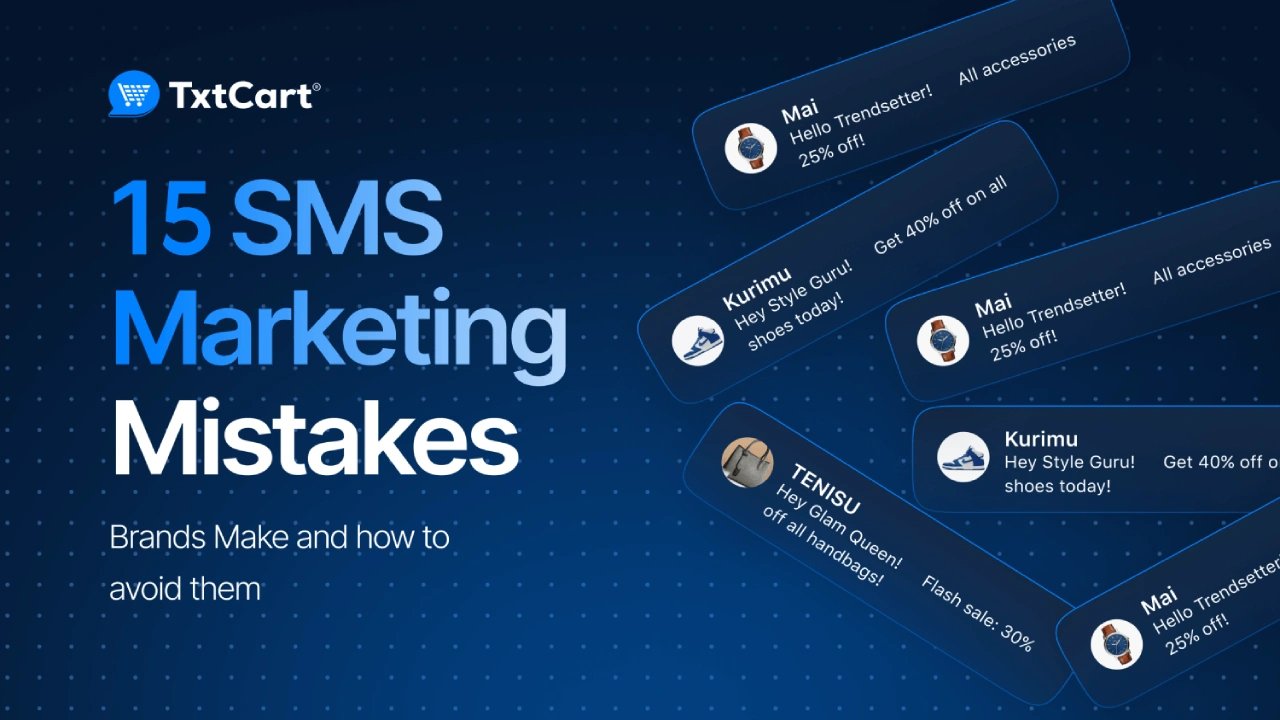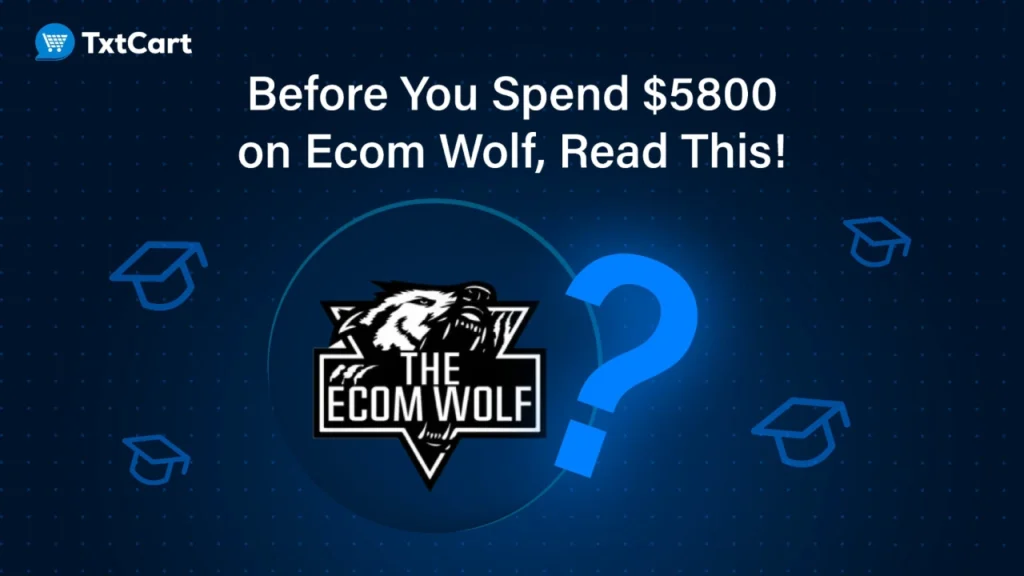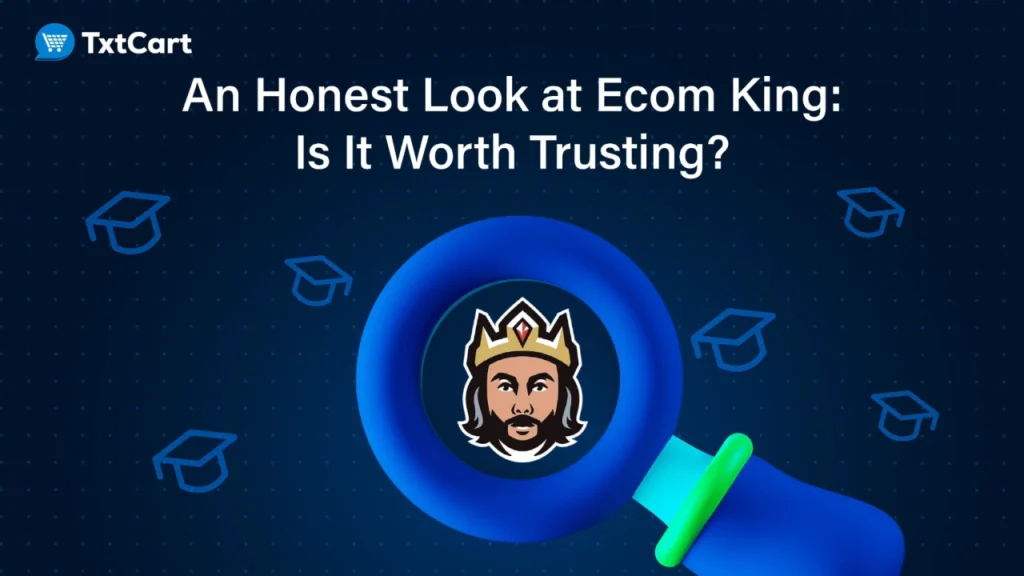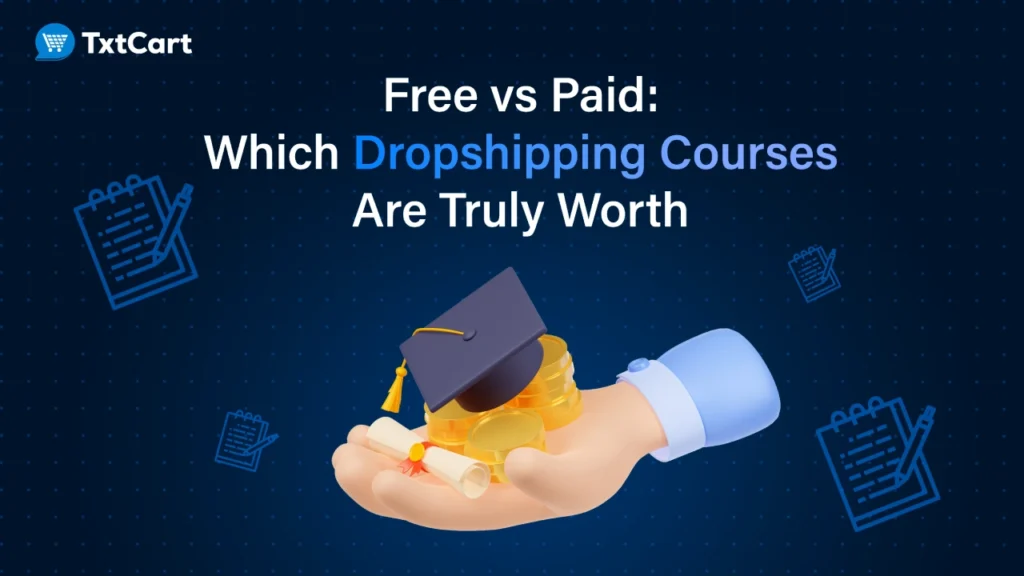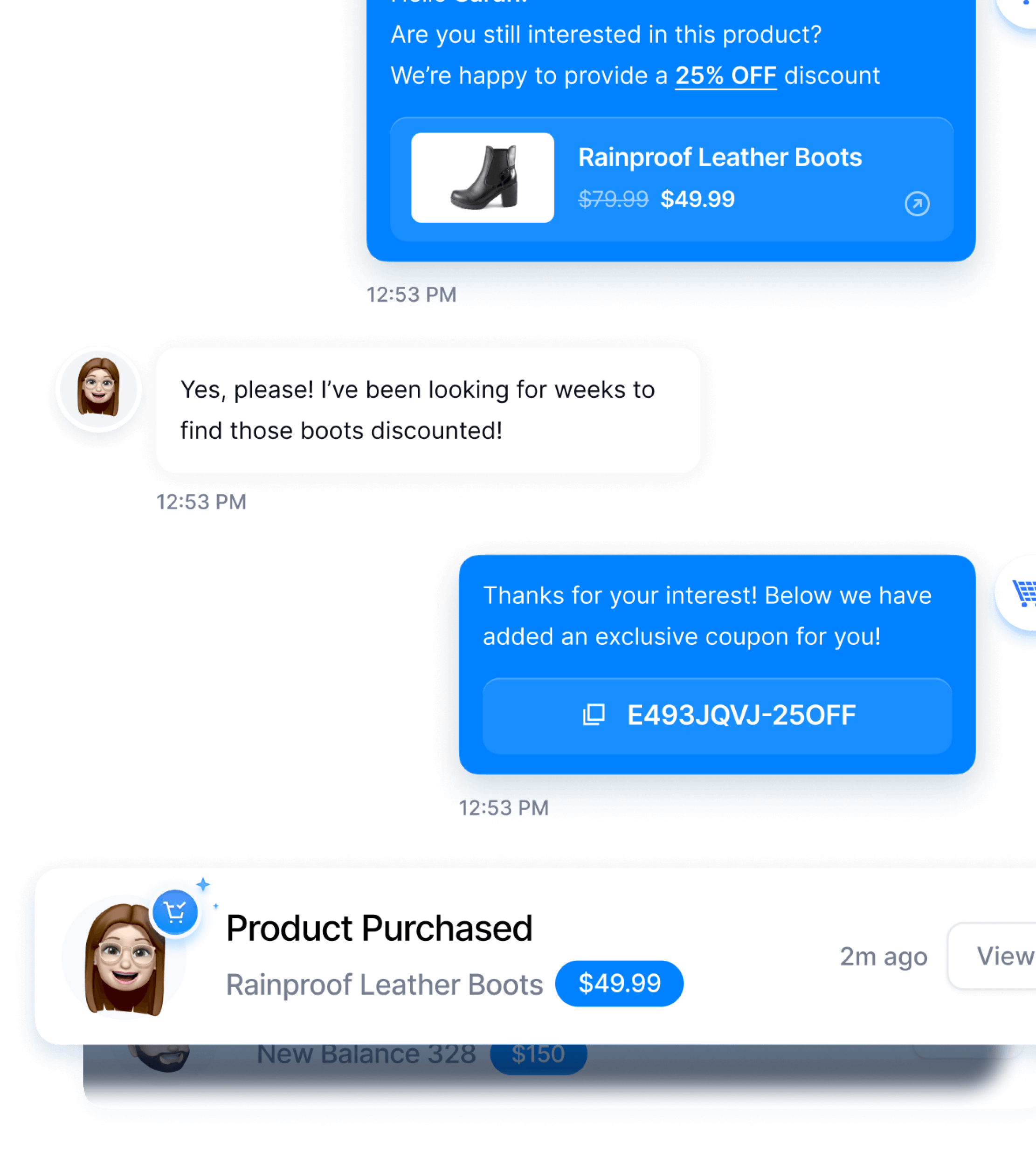Ever wondered why your SMS campaigns aren’t driving the results you expected, despite doing everything by the book? You might be making subtle yet costly SMS marketing mistakes that silently hurt your engagement, conversions, and even your brand reputation. One wrong move can do more harm than good.
But here’s the good news: once you know what to avoid, your SMS marketing efforts can turn into a powerful tool for growth.
In this blog, we’ll cover:
- The most common SMS marketing mistakes that hurt ROI
- How poor timing, targeting, and messaging wreck even the best campaigns
- Simple, actionable strategies to avoid these pitfalls and drive more success
TL;DR
- Implement double opt-in with clear frequency expectations (e.g., “2-4 texts/month”) and send an immediate welcome text that confirms the subscription
- Schedule messages based on local time zones, targeting 12PM-2PM for East Coast and 5PM-7PM for West Coast customers for optimal engagement
- Use a single, consistent phone number with your brand name clearly stated at the beginning of each message
- Create mobile-specific landing pages with large tap targets and load times under 3 seconds for all SMS links
- Segment campaigns by purchase behavior (first-time buyers, repeat customers, cart abandoners) and personalize with dynamic content like product names
- A/B test one variable at a time (CTA, timing, offer format) with small audience segments before scaling to your full list
- Track campaign-specific metrics that align with goals—conversion rate for sales campaigns, reply rate for engagement campaigns, and unsubscribe rate for retention efforts
15 Costly SMS Marketing Mistakes (And How to Avoid Wrecking Your ROI)
One wrong message can tank your open rates, frustrate subscribers, and kill conversions. These are the mistakes to avoid if you want your SMS campaigns to drive real results.
1. Sending text messages without permission/opt-in
Blasting text messages to people who haven’t explicitly opted in isn’t just bad practice—it’s illegal. It also instantly ruins trust. Consumers are selective about who they allow into their inboxes. When brands skip consent, they risk being seen as intrusive, damaging both their brand reputation and deliverability rates.
Solution: Always start with explicit, written consent not just to stay compliant with regulations like TCPA and GDPR, but to ensure you’re reaching the right audience that actually wants to hear from you.
Here’s how to do it well:
- Craft opt-in prompts that clearly explain what subscribers will receive—including the type of messages (e.g., new drops, exclusive offers) and how often they’ll receive text messages (e.g., “2–4 texts/month”). This transparency sets the right expectations and reduces opt-outs later.
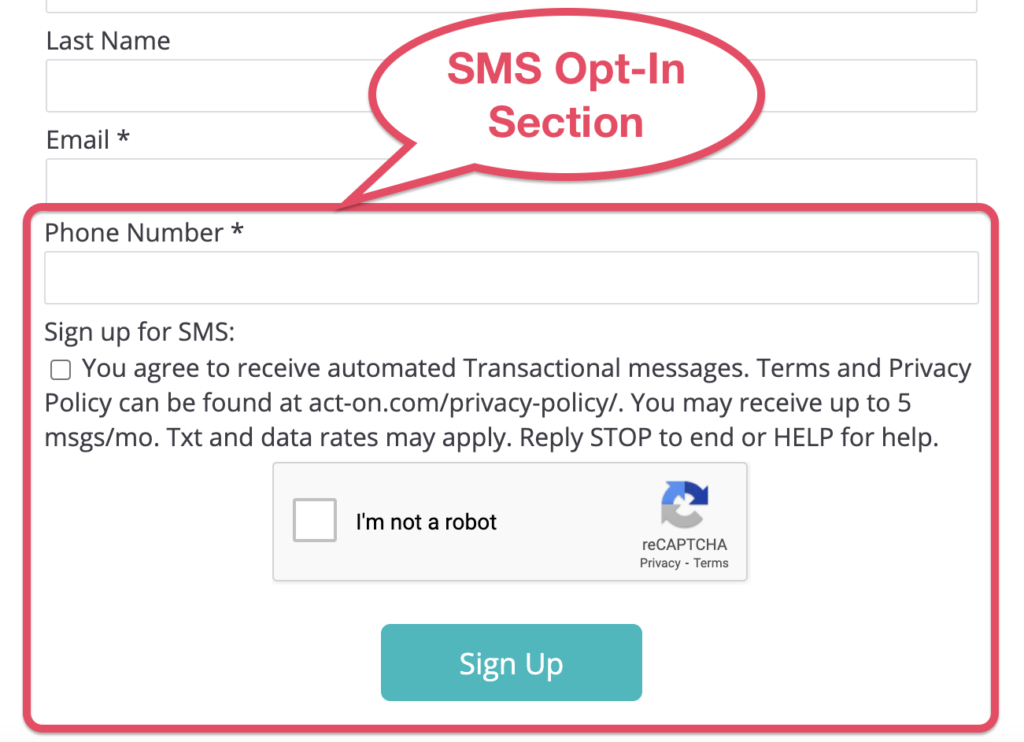
- Immediately send a welcome text that confirms the subscription. TxtCart’s AI copy assistant makes it easy to write a warm, high-converting welcome message in seconds.
For example, Gamenetics collaborated with TxtCart to run a personalized SMS campaign. The message below is just one part of it—a friendly, well-timed welcome text that introduces the brand, offers value, and opens the door to two-way communication.
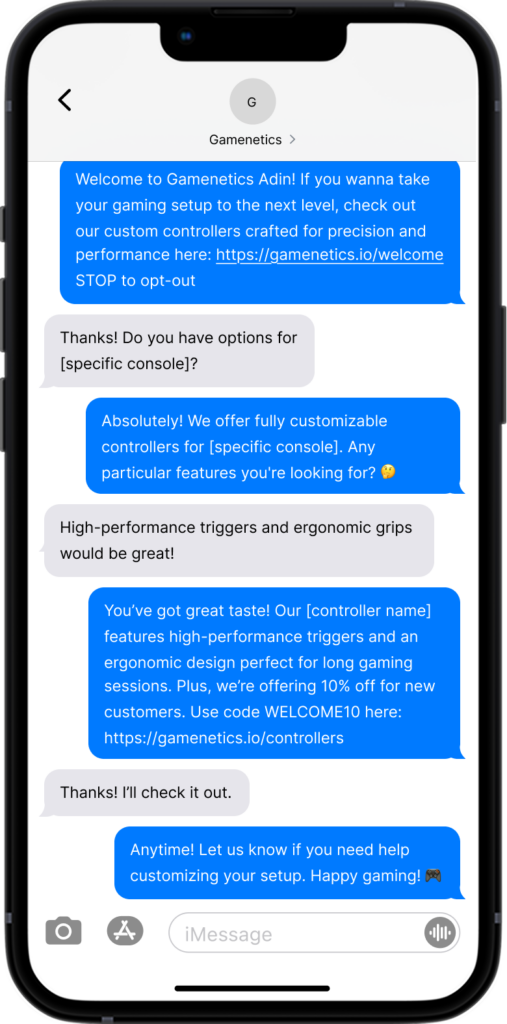
- Add social proof near your opt-in forms. Mention how many people have already subscribed, or highlight positive feedback from existing SMS subscribers. It’s a simple way to build credibility and boost sign-ups.
Pro Tip: Offer something valuable in exchange for opt-in, a promo code, exclusive deal, or first access to limited drops, to increase opt-ins and attract engaged consumers to your SMS list.
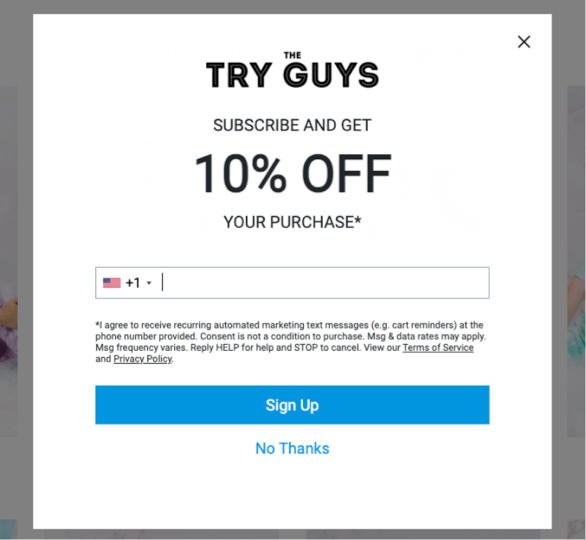
Read Next:
- The Ultimate Guide to SMS Opt-in for 2025 (Tips + Examples)
- How to Craft the Perfect SMS Welcome Series (+ Templates)
2. Not giving an opt-out option
Not including an opt-out option isn’t just a poor experience—it’s a compliance risk. Some SMS subscribers will lose interest or no longer find your messages relevant. If there’s no easy way to unsubscribe, you risk frustrating users, increasing complaints, and harming your brand reputation.
Solution: Include clear opt-out instructions in every message. A simple line like “Reply STOP to unsubscribe” is enough.
Here’s how to do it well:
- Keep the opt-out language short, direct, and easy to find—avoid hiding it in long blocks of text.
- Monitor your opt-out rate. A spike usually signals problems with message frequency, timing, or relevance. Use that data to adjust your marketing strategy.
For example, Toroe Eyewear partnered with TxtCartto send personalized follow-up messages that feel natural and helpful while staying compliant. The opt-out is smoothly integrated:
“Here’s your cart: https://toroeeyewear.io/cart STOP to opt-out” — clear, respectful, and doesn’t interrupt the conversation flow.
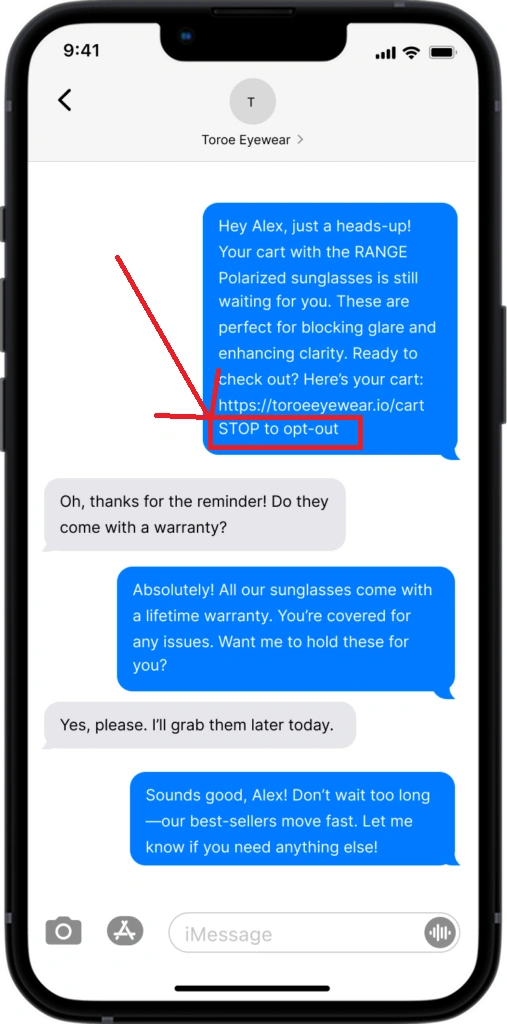
Read Next:
- All you could know about SMS Marketing Compliance for Shopify
- Complete Guide to SMS Marketing Compliance
3. Sending untimely messages
Timing can make or break your SMS marketing campaign. Sending text messages during work hours, late at night, or early in the morning interrupts people’s routines and, worse, it makes your brand feel intrusive. Since most people read text messages within minutes of receiving them, bad timing often means missed engagement, lower conversions, or even opt-outs.
Solution: Optimize send times to match your audience’s habits, time zones, and context.
Here’s how to do it well:
- Segment by time zone to avoid blasting everyone at once. Use scheduling tools that allow you to send based on local time, so your messages land when people are most likely to engage.
- Use behavioral data. Look at past open rates and conversion trends by time and day. Identify patterns—do subscribers click more in the evening? Are weekends performing better for sales-related content?
Here’s a simple example of how to segment and analyze based on time and behavior:
| Segment | Time Zone | Best Send Time | Best Performing Days | Message Type |
|---|---|---|---|---|
| East Coast U.S. Customers | EST (UTC -5) | 12 PM – 2 PM (Lunch) | Thursday, Saturday | Flash Sales, Product Drops |
| West Coast U.S. Customers | PST (UTC -8) | 5 PM – 7 PM (After Work) | Friday, Sunday | Promo Codes, Upsell Offers |
| UK Customers | GMT (UTC +0) | 8 AM – 10 AM (Commute) | Tuesday, Friday | New Arrivals, Announcements |
| Lapsed Buyers | All Time Zones | 6 PM – 8 PM (Evening) | Wednesday, Sunday | Win-back, Abandoned Cart |
Use this as a starting point, then refine based on your audience’s actual engagement patterns using performance data from your own SMS campaigns.
- A/B test send times. Send the same message to two similar audience segments at different times and track performance. Over time, you’ll find your engagement sweet spot.
P.S. TxtCart’s scheduler allows you to schedule SMS campaigns based on your subscribers’ time zones, ensuring your messages reach them at the right moment, without disrupting their day.
Read Next: The Best Time to Send SMS Marketing Messages
4. Sending texts to opted-out customers
Including an opt-out option is only part of the job—what you do after someone unsubscribes matters just as much. Continuing to send SMS messages to opted-out users is a fast track to getting flagged as spam. It creates frustration, erodes trust, and can seriously damage your brand reputation and deliverability.
Solution: Make sure opt-outs are automatically and instantly honored—no exceptions.
Here’s how to do it well:
- Use an SMS platform that auto-removes opted-out numbers from future sends. This ensures compliance and avoids human error.
- Regularly audit your contact lists to catch any sync issues, especially if you’re integrating with other tools like CRMs or eCommerce platforms.
- Test your opt-out flow by going through it yourself. Ensure that when someone replies “STOP,” they truly stop receiving any future SMS marketing messages.
- Document unsubscribes and use analytics to track trends. High opt-out rates could point to larger issues like irrelevant messaging or poor timing.
Pro Tip: Treat opt-outs as valuable feedback. Look for patterns—are people unsubscribing after certain types of messages or offers? Use that data to improve your future SMS campaigns.
5. Providing only one-way communication
Did you know customers are 4.5x more likely to respond to SMS messages from brands than through any other channel? Yet, many businesses still treat SMS as a one-way tool—pushing marketing messages without allowing replies. This not only limits engagement but also frustrates customers who expect real-time help or interaction.
Solution: Adopt a two-way SMS communication strategy that allows for real, humanized conversations.
Here’s how to do it well:
- Enable replies so subscribers can ask questions or get support without switching channels.
- Automate common responses to FAQs using pre-set replies or AI, while routing complex questions to a live agent if needed.
- Personalize your replies with context—like order history or preferences—to turn routine interactions into relationship-building moments.
- Make sure responses are timely. Even automated replies should feel responsive and relevant.
Pro Tip: TxtCart allows two-way, AI-powered SMS conversations, helping brands respond faster and save on customer support costs up to 32x compared to human agents.
For example, Joyride partnered with TxtCart to level up their SMS strategy. Here’s what they were doing before: sending the same one-way promo regardless of customer replies. After switching to TxtCart, their approach shifted to real-time, two-way communication—providing personalized answers instantly to improve customer experience and increase conversions.
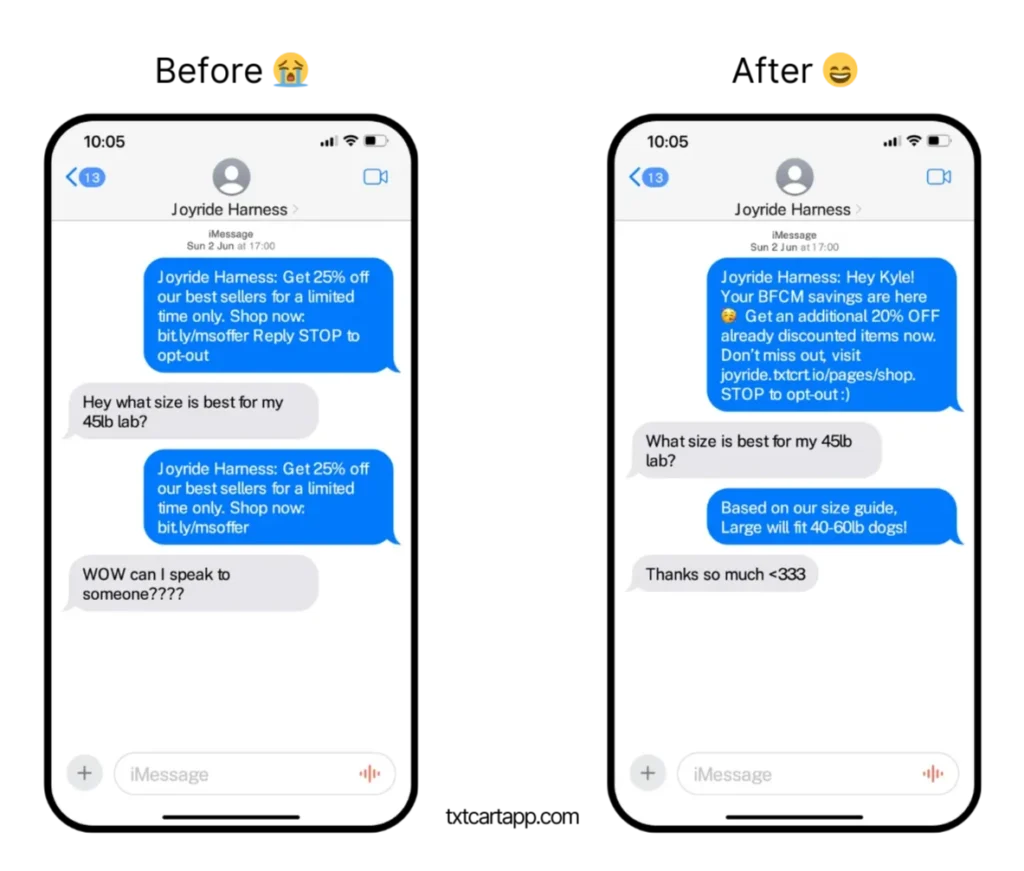
BTW, JoyRide drove over $1.8M in revenue by recovering abandoned carts using TxtCart!
Read Next:
- Conversational SMS Guide: 15+ Best Examples, Uses, & Tips
- 9 Conversational SMS Examples That Generated $6M+
6. Sending messages from random phone numbers
Switching sender numbers between messages creates confusion and weakens brand trust. When subscribers receive texts from unfamiliar or inconsistent numbers, they’re less likely to recognize your brand—or worse, may assume it’s spam. It also prevents them from saving your number, which is crucial for building familiarity and trust in future SMS marketing messages.
Solution: Use just one number and name for all your SMS marketing campaigns.
Here’s how to do it well:
- Use a dedicated short code or branded sender ID to ensure every message comes from a recognizable source. This reinforces your brand identity and boosts open rates.
- Avoid rotating numbers unless it’s absolutely necessary. If you must use more than one number (for deliverability reasons), make sure your branding is crystal clear at the start of each message.
- Introduce yourself clearly in the first few messages of any new thread, especially to new SMS subscribers—e.g., “Hi, it’s [Your Brand]—here’s your exclusive offer!”
For example, Huckberry opens its message by clearly stating the brand name before sharing the offer.

7. Sending texts without any strategy
Random, one-off SMS campaigns with no clear connection to your overall marketing strategy don’t just underperform—they create confusion. Your text messages shouldn’t feel like they’re coming from a different planet than your emails, social media posts, or website. When SMS feels disconnected from the rest of your brand messaging, it’s harder for customers to trust or act on it.
Solution: Treat SMS as an integrated channel within your broader marketing ecosystem, not a standalone tool.
Here’s how to do it well:
- Align your SMS content with ongoing campaigns across email, social, and website. If you’re running a referral program or flash sale, reinforce that same message everywhere for consistency and impact.
- Create an SMS calendar that mirrors your main marketing calendar. Plan key sends around product drops, promotions, and seasonal events to avoid last-minute, off-brand texts.
- Segment your messaging goals. Use SMS for what it does best: immediacy, urgency, and personalization. For example, use it to recover abandoned carts, confirm purchases, or deliver exclusive limited-time offers—not to replicate what email is already doing.
Here’s an example of how to integrate SMS into your broader marketing strategy:
| Campaign Type | Primary Channel | Supporting SMS Use Case |
|---|---|---|
| Product Launch | Email + Social | Tease early access or drop a “live now” SMS |
| Flash Sale | Website Banner | Send a time-sensitive reminder with a countdown via SMS |
| Referral Program | Blog or Landing Page | Send a reminder with the referral link directly via SMS |
| Cart Abandonment | On-site Trigger | Personalized recovery message with incentive |
| Loyalty Reward | Alert VIPs via SMS about exclusive perks |
Read Next: 7 Best eCommerce Sales Channels for Scaling Your Business
8. Sending a link to a non-optimized website
Your SMS subscribers are just one tap away from your content. In fact, 90% of text messages are read within 3 minutes, and many users click through instantly. But if the website link you send leads to a desktop-only or slow-loading page, you’ve just created a frustrating experience and likely lost the customer. Poor mobile optimization kills conversions, no matter how great your message or offer is.
Solution: Ensure every link you send via SMS leads to a fast, mobile-friendly experience.
Here’s how to do it well:
- Test every landing page on mobile before adding it to an SMS campaign. Check for load speed, layout, and clickable elements. If users have to pinch, scroll awkwardly, or wait more than a few seconds, you’re losing them.
- Use concise, mobile-optimized URLs. Avoid long, cluttered links that break in messages or look untrustworthy. Use branded short links when possible to boost click-through rates and maintain brand credibility.
- Design mobile-first. Make sure CTAs are large enough to tap, images scale properly, and the checkout flow is seamless. Mobile UX should be your default, not an afterthought.
9. Buying SMS lists
Buying SMS lists might seem like a shortcut to growth, but it’s a fast track to legal trouble and low engagement. Sending marketing messages to people who haven’t opted in directly violates laws like TCPA and GDPR. Plus, these recipients don’t know you, didn’t ask to hear from you, and will likely block, ignore, or mark your messages as spam, damaging your sender reputation and deliverability.
Solution: Grow your SMS list organically—even if it takes time. The quality of your SMS subscribers matters more than the quantity.
Here’s how to do it well:
- Use on-site popups, banners, or checkout opt-ins to invite users to join your SMS list with a clear value proposition—like exclusive offers, early access, or limited drops.
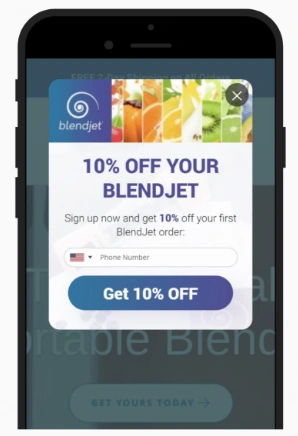
- Promote opt-ins across your other channels. Add opt-in prompts to your email campaigns, social media posts, and landing pages to drive consistent sign-ups.
- Offer a compelling incentive. A one-time promo code, VIP access, or loyalty points can increase opt-in rates significantly—especially when paired with a strong call to action.
For example, GREATS offers early VIP access with a 30% off promo code—creating urgency and exclusivity that drives action.
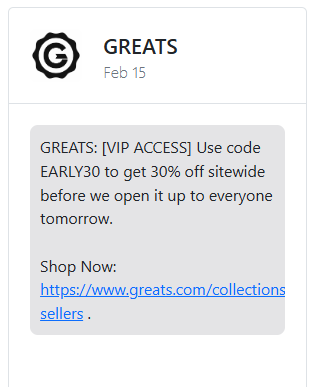
Pro Tip: Focus on quality over speed. A small list of highly engaged subscribers will outperform a massive list of strangers every time.
10. Sending too many texts
There’s no magic number for how many SMS messages you should send, but there is a clear line between staying top-of-mind and becoming annoying. Over-messaging can overwhelm your audience, especially when they’re also hearing from multiple other brands. This leads to fatigue, lower engagement, and higher opt-out rates.
Solution: Be intentional with every message. Focus on relevance, timing, and value—not volume.
Here’s how to do it well:
- Set clear expectations at opt-in—let subscribers know how many messages they’ll receive per week or month. This manages perception and builds trust from day one.
- Monitor engagement metrics like click-through and opt-out rates. If you notice a dip in performance or spike in unsubscribes, it’s a sign you’re texting too much—or not providing enough value.
- Prioritize quality over quantity. Don’t send just to stay visible. Send when you have something timely, relevant, or valuable—like a flash sale, restock alert, or exclusive drop.
While there’s no one-size-fits-all rule, here’s a general frequency guideline based on message type. Use this as a starting point, then adjust based on engagement, opt-out rate, and customer feedback.
| Message Type | Suggested Frequency |
|---|---|
| Promotional Offers | 2–4 times/month |
| New Product Drops | 1–2 times/month |
| Cart Recovery Reminders | 1–2 per abandoned cart event |
| Loyalty/VIP Updates | 1–2 times/month |
| Order & Shipping Updates | As needed |
| Feedback/Review Requests | 1–2 days post-delivery |
11. Not including CTAs in the text
SMS click-through rates are nearly 30x higher than email, but only if you give your audience something to click on. If your goal is to drive sales, sign-ups, or any action, your message needs a clear call to action. Without it, even the most compelling message can fall flat. Not every text needs a CTA (like shipping updates), but for promotional or engagement-focused campaigns, it’s non-negotiable.
Solution: Use direct, actionable CTAs that align with your campaign goal and clearly indicate the next step.
Here’s how to do it well:
- Match the CTA to the goal. If you’re launching a sale, use “Shop Now.” For sign-ups: “Join Today.” For referrals: “Share & Save.” Here’s a quick reference to help you choose the right CTA for your campaign:
| Campaign Goal | Recommended CTA |
|---|---|
| Drive sales | Shop Now / Get the Deal |
| Increase sign-ups | Join Today / Sign Up Now |
| Referral programs | Share & Save / Refer a Friend |
| Restock notifications | Buy Before It’s Gone |
| Product launch | Explore New Arrivals |
| Limited-time offers | Claim Your Offer / Act Fast |
| VIP / Early access | Unlock VIP Access |
| Event promotion | RSVP Now / Save Your Spot |
- Place the CTA near the end of the message so it’s the final prompt users see before deciding to click.
- Keep it simple and mobile-friendly. Shorten links and use clear language so users don’t have to think twice.
- Use urgency or exclusivity when appropriate: phrases like “limited time,” “VIP access,” or “before it ends tonight” can significantly improve response rates.
Huckberry nails this with a clear and urgent CTA: “SHOP TO WIN”—paired with an incentive and deadline to drive immediate action.
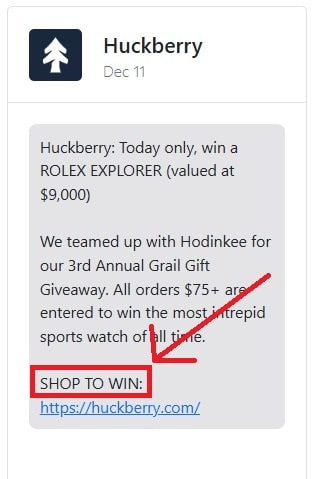
12. Sending the same text multiple times
Nothing frustrates a subscriber faster than getting hit with the same message over and over. It not only feels lazy and impersonal but also gives the impression that your brand doesn’t manage its SMS list well. Repetitive messaging can lead to opt-outs, reduced engagement, and damaged trust.
Solution: Send each message with intention and avoid direct repetition. Instead, vary your content while reinforcing your goal.
Here’s how to do it well:
- Use message variation to promote the same offer in different ways—change your hook, angle, or incentive without repeating the original text. Let’s see how you can vary your SMS while promoting the same offer:
| Variation Type | Example 1 | Example 2 |
|---|---|---|
| Hook | “Still thinking it over?” | “You left something behind!” |
| Angle | “Ends tonight—last chance to save 10%” | “Snag $10 off before it’s gone” |
| Incentive | “Get 10% off + free shipping” | “Here’s $10 off, just for you.” |
| Personalization | “Hey [Name], want us to hold your cart?” | “We saved your cart—need any help?” |
Rotate these elements to keep your follow-ups feeling fresh, relevant, and personalized—without sounding repetitive.
- Track send history to avoid repeat sends to the same subscriber. Use proper segmentation and automation logic.
- Set up automated follow-ups with added value. For instance, instead of resending the same cart reminder, offer something extra—like a discount, bonus item, or product recommendation.
For example, Crossnet used TxtCart to follow up with a cart abandoner. Instead of repeating the original nudge, they added value by answering product questions, offering a $10 discount, and sharing a direct cart link—creating a helpful, tailored experience that feels fresh and respectful.
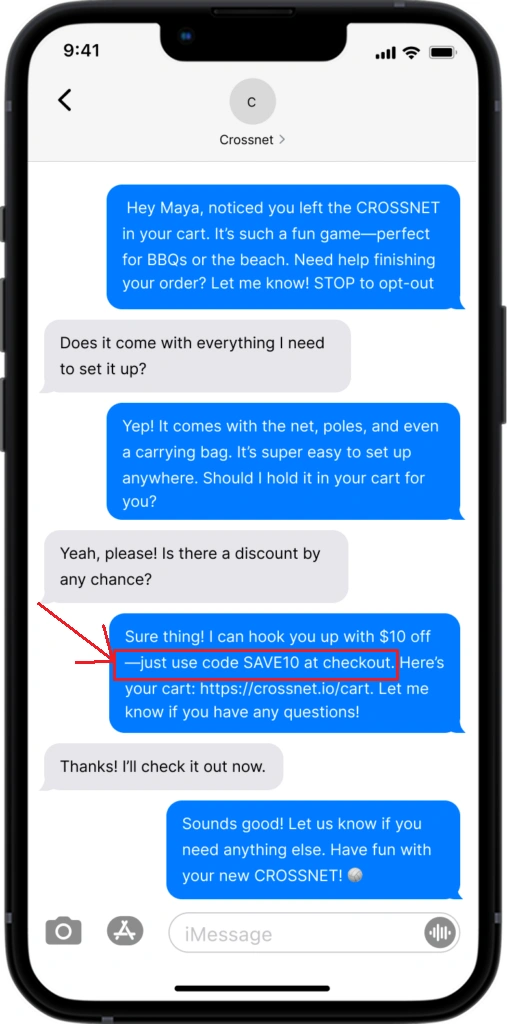
13. Not sending personalized messages
Sending generic, one-size-fits-all text messages is a missed opportunity. In fact, 92% of marketers agree that customers expect a personalized experience, and when done right, personalization drives significantly higher engagement and sales.
Messages that reference a customer’s past purchases, preferences, or even their name signal that your brand sees them as individuals, not just numbers on a list.
Solution: Use your customer data to segment and personalize SMS campaigns based on behaviors, interests, and history.
Here’s how to do it well:
- Segment your list by behavior and purchase history. For example, target repeat buyers with loyalty perks or re-engage inactive customers with win-back campaigns. Here’s how to segment your audience for more personalized SMS campaigns:
| Customer Segment | Behavior Trigger | Suggested SMS Approach |
|---|---|---|
| First-time buyers | Just made their first purchase | Send a welcome text + product tips or how-to guide |
| Repeat customers | Purchased 2+ times | Offer loyalty perks, early access, or VIP promos |
| Cart abandoners | Left items in the cart | Trigger follow-up with a reminder or discount |
| Inactive subscribers | No engagement in 30+ days | Launch a win-back campaign with a personalized offer |
| Product-specific buyers | Purchased from a specific category | Recommend related or complementary products |
| High spenders | Above-average order value | Offer exclusive bundles or premium add-ons |
Personalization starts with segmentation—use the right trigger to send the right message, at the right time.
- Use merge tags to add first names, product names, or other dynamic content into your messages—like: “Hey [Name], your favorite item is back in stock!”
- Recommend related products based on what they’ve previously bought.
For example, Organi partnered with TxtCart to run an SMS campaign. In the example below, you can see how TxtCart’s conversational AI suggests a moisturizing shampoo based on a customer’s recent haircare purchase. This kind of targeted upsell feels helpful—not pushy—and boosts both satisfaction and average order value.
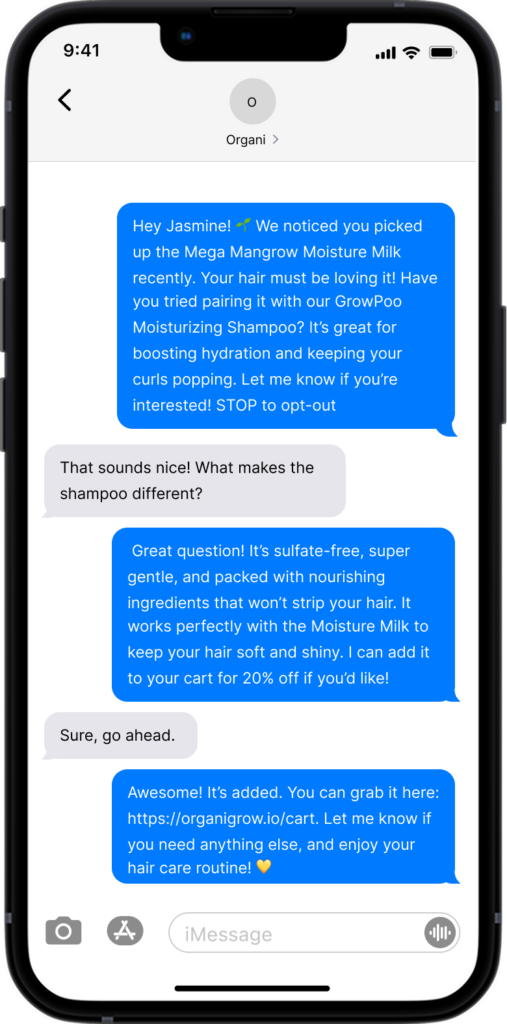
Pro tip: Use TxtCart’s advanced segmentation to target audiences based on their purchase habits, engagement patterns, and interaction history—making it easy to send personalized and perfectly timed review requests.
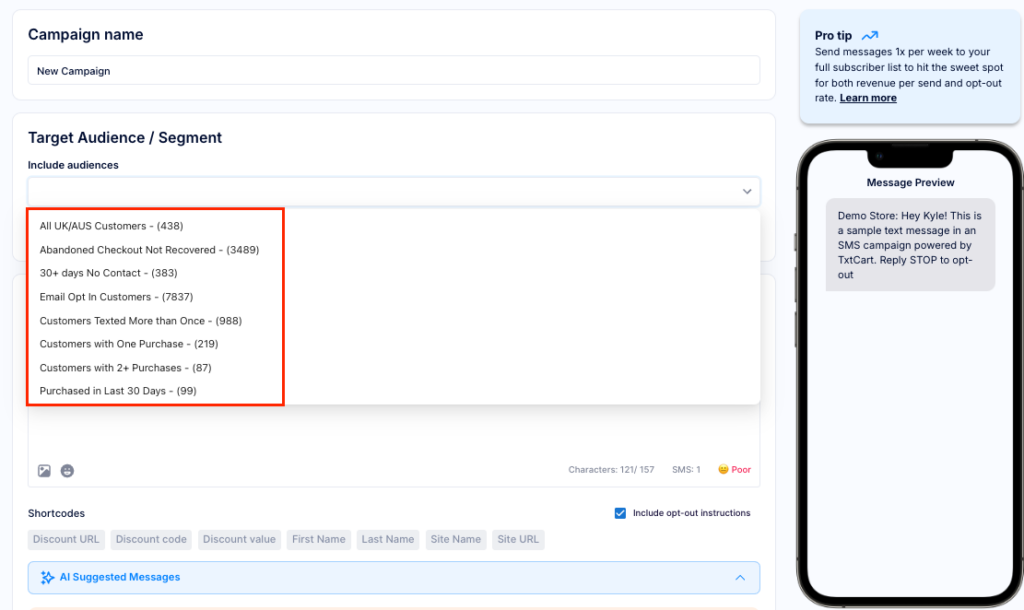
Read Next:
- What is SMS Personalization – Key Tips and Advice
- How to Send Personalized Text Messages That Sell
- What is SMS Segmentation, Best Practices & Examples
14. Skipping A/B testing
Sending your campaign to your full list without testing it first can lead to avoidable (and expensive) mistakes—like typos, broken links, bad timing, or underperforming copy. Without A/B testing, you’re relying on guesswork rather than data to decide what works best. Even small changes in wording or timing can lead to major differences in engagement and conversions.
Solution: Make A/B testing a standard part of your SMS marketing workflow—not a nice-to-have.
Here’s how to do it well:
- Test one variable at a time. This could be the CTA, message length, send time, offer format, or tone. Keep everything else consistent to isolate what’s working.
- Split your audience evenly. Send version A to one group and version B to another of equal size and similar characteristics for accurate comparison.
- Start small, scale smart. Once you know which version performs better, use it for the remainder of your list or future campaigns.
Pro tip: TxtCart simplifies A/B testing by letting you test variations and track which version gets the most clicks, replies, or conversions.
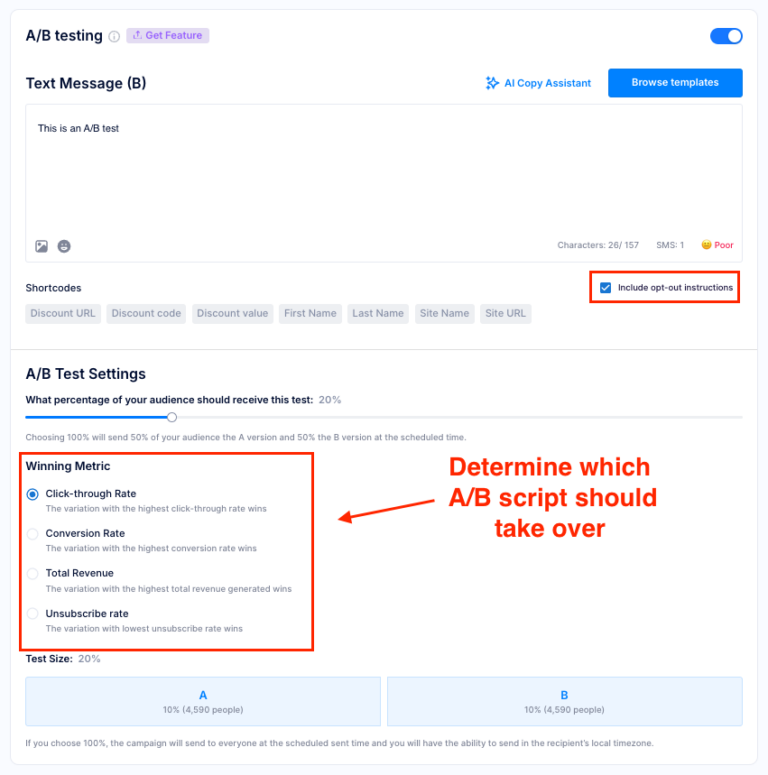
Read Next: SMS A/B Testing: 15 Types of SMS Tests & Examples
15. Not monitoring SMS campaigns
Even the most well-crafted SMS marketing messages are only as good as their performance. If you’re not tracking results, you’re flying blind and missing valuable insights that could improve future campaigns. Without monitoring, you won’t know which messages are converting, which are falling flat, or why subscribers are opting out.
Solution: Regularly track and analyze key performance metrics to understand what’s working and optimize accordingly.
Here’s how to do it well:
- Track core metrics like click-through rate (CTR), conversion rate, bounce rate, unsubscribe rate, and reply rate. Each tells you something different about how your audience is engaging.
- Tie metrics to campaign goals. For example, if your goal is sales, track conversions. If it’s awareness, look at clicks or replies. Don’t measure blindly—measure with intent. Here’s a breakdown of key SMS metrics and when to track them:
| Campaign Goal | Metrics to Track | What It Tells You | Improvement Strategy |
|---|---|---|---|
| Drive Sales / Conversions | Conversion rate, CTR, revenue generated | How effective your message is at turning clicks into purchases | Focus on segmenting your audience based on purchasing behavior. Personalize product recommendations and create urgency with time-limited offers. |
| Increase Engagement | Click-through rate, reply rate | How relevant and compelling your message is | Test different messaging styles and formats, like offering incentives or free shipping. Tailor your content to the audience’s interests and track which appeals drive engagement. |
| Build Awareness | Delivery rate, CTR | Whether people are seeing and showing interest | Focus on optimizing send times and ensuring proper segmentation. Craft attention-grabbing subject lines and test content variations for higher CTR. |
| Improve Retention | Unsubscribe rate, bounce rate | Whether your message frequency or content is turning users off | Personalize follow-up messages based on past interactions. Consider reducing message frequency and offering exclusive content to increase retention. |
| Test Messaging / Offers | A/B test results, CTR, conversion rate | Which version of your SMS performs better | Regularly rotate and refine your offers based on A/B test results. Experiment with timing, discounts, and calls to action to see what resonates best with your audience. |
- Use these insights to make smarter, data-backed decisions and continuously improve your SMS marketing strategy.
- Compare performance across segments. Analyze how different groups (new vs. repeat buyers, VIPs vs. general audience) respond to the same message to uncover new opportunities.
- Optimize based on insights. If CTR is low, tweak your CTA or timing. If unsubscribe rates spike, revisit your message frequency or content relevance.
Pro Tip: TxtCart’s advanced campaign and revenue analytics give you real-time insights into campaign performance—so you can make fast, data-driven decisions to improve future sends.

Read Next: SMS Marketing Analytics: 10 SMS Metrics You Cannot Ignore
Power Your SMS Marketing with TxtCart
Avoiding the above-mentioned common SMS marketing mistakes can be the difference between frustrating your audience and building lasting customer relationships.
With the right strategy and tools like TxtCart, you can personalize messages, automate smart campaigns, and integrate SMS into your full marketing mix. It’s not just about sending texts, it’s about sending the right ones that drive real results.
Organi Grow Hair, a vegan and organic haircare brand, used TxtCart’s 2-way SMS to recover $25K monthly, drive 42% reply rates, and deliver 9,500+ personalized campaign orders.
$1,248,723
Revenue Attributed to SMS
26,241+
Orders Attributed to SMS
16.9x
SMS Attributed ROI

“TxtCart has really built something special and we’ve been a fan for over 3 years. The organic conversations pair so well with our organic products, providing additional revenue and customer satisfaction.”
Founder, Organi Hair
